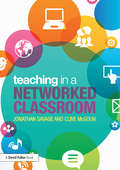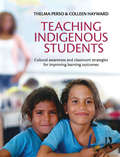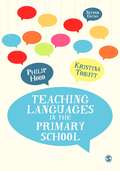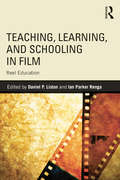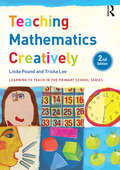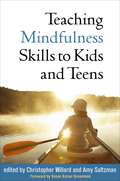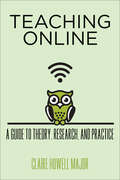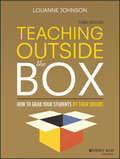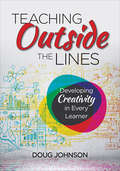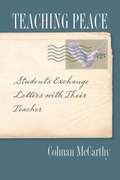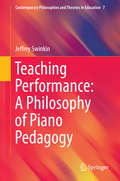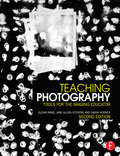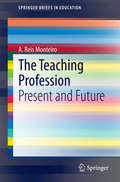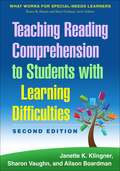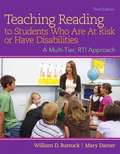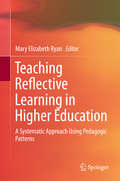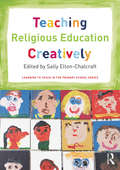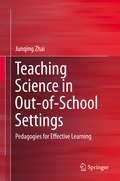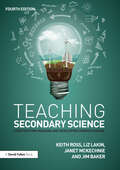- Table View
- List View
Teaching in a Networked Classroom
by Jonathan Savage Clive McGounThe pace of technological change has made the immediate and long-term future difficult, if not impossible, to predict. Teachers are forced to imagine the world they are preparing their students to live in. In this situation creativity becomes a vital resource for enabling uncertain futures to be embraced and an important attribute for students to have both for their learning and their employability in the future. In this book, the authors argue that creativity is a social and collaborative process that can be enhanced through online and digital technologies. Filled with case studies and practical tasks, it shows teachers how they can develop an approach to teaching and learning with digital technologies that is inherently social, collaborative and creative. Including case studies and practical examples of projects and lessons throughout, the chapters cover: Learning in a networked society An examination of sharing practices and how knowledge can be shared more effectively Potential pitfalls of virtual learning environments and public social networking sites Using digital media to plan schemes of work and lessons How to facilitate meaningful collaboration and discussion through digital media Creating online environments to enable students to share their understandings and learning Bringing together key ideas about creativity, collaborative learning and ICT in the classroom, this timely book will be an invaluable resource for all teachers.
Teaching Indigenous Students: Cultural awareness and classroom strategies for improving learning outcomes
by Thelma PersoIndigenous children, like all children, deserve a future they choose for themselves. This book aims to empower teachers to help halt the cycle of disadvantage for Aboriginal and Torres Strait Islander students and make a real difference to their relationships, learning outcomes and opportunities in the short and long term.Based on their many years of experience in teaching and research, the authors provide approaches that have been proven to be effective. There are strategies for developing sensitivity to a student's cultural background, creating a tone in the classroom conducive to learning, building strong teacher-student relationships and effectively managing student behaviour. The authors show how to bridge the demands of the curriculum with the learning Indigenous students bring with them to the classroom and how to work with the learning styles of Aboriginal and Torres Strait Islander students. There is a focus on the best approaches for assessment and an exploration of the particular challenges for teachers of students in remote locations.Both practical and inspiring, this is an essential reference for all teachers working with Indigenous students, whether they be in the city or rural areas, in a class of twenty-five or just one student.'Teaching Indigenous Students should be essential reading for all educators. This book will challenge the mind and stir the spirit of the practitioner and will help forge a new future for the teaching of Aboriginal and Torres Strait Islander students. A seminal piece of work.' - Professor Mark Rose, Executive Director of Indigenous Strategy and Education, La Trobe University'Hayward and Perso provide the knowledge, wisdom and insights that guarantee success to any teacher who is prepared to embrace their messages, and work hard to make Indigenous students stronger and smarter.' - Dr Chris Sarra, Chairman, Stronger Smarter Institute'This is a quality piece of work that will contribute to a more informed Australian teaching workforce and more happier and successful Indigenous learners.' - Professor Peter Buckskin PSM FACE, Dean, Indigenous Scholarship, Engagement and Research, University of South AustraliaTeaching Indigenous Students has been shortlisted for the 2016 Educational Publishing Awards in the category Tertiary (Wholly Australian) Student Resource.
Teaching Languages in the Primary School
by Philip Hood Kristina TobuttLanguages are now a more important part of primary education than ever before, and all successful primary teachers need to understand the principles that support good language teaching and learning. This second edition provides a coherent overview of teaching and learning languages, combining practical strategies for use in the classroom with engaging coverage of how to teach, informed by academic research and theory. Key features of this new edition: Fully updated coverage of policy and curriculum developments, including the 2014 National Curriculum and the Teachers' Standards A new chapter on curriculum, planning and assessment for KS2 Expanded coverage of the transition from primary to secondary school and the implications for teaching More examples of creative teaching and learning throughout. This is essential reading for all students studying primary languages on initial teacher education courses, including undergraduate (BEd, BA with QTS), postgraduate (PGCE, School Direct, SCITT), and also NQTs.
Teaching Languages in the Primary School
by Philip Hood Kristina TobuttLanguages are now a more important part of primary education than ever before, and all successful primary teachers need to understand the principles that support good language teaching and learning. This second edition provides a coherent overview of teaching and learning languages, combining practical strategies for use in the classroom with engaging coverage of how to teach, informed by academic research and theory. Key features of this new edition: Fully updated coverage of policy and curriculum developments, including the 2014 National Curriculum and the Teachers’ Standards A new chapter on curriculum, planning and assessment for KS2 Expanded coverage of the transition from primary to secondary school and the implications for teaching More examples of creative teaching and learning throughout. This is essential reading for all students studying primary languages on initial teacher education courses, including undergraduate (BEd, BA with QTS), postgraduate (PGCE, School Direct, SCITT), and also NQTs.
Teaching, Learning, and Schooling in Film: Reel Education
by Ian Renga Daniel ListonFilms about education provide many of the most popular interpretations of what teaching and learning mean in schools. An analysis of this medium reveals much about the historical, cultural, political, and philosophical dimensions of education. Timely and engaging, this book fills a gap for scholarly and informed public commentary on the portrayal of education in film, offering a wide range of conceptual and interpretive perspectives. Teaching, Learning, and Schooling in Film explores several key questions, including: What does it mean to be a good teacher? How do these good teachers instruct? When is and what makes teaching complex? What constitutes learning? Do educational reforms work? The book’s interdisciplinary group of contributors answers these important questions in essays highlighting Hollywood, independent, and documentary films. Prospective and practicing teachers will engage with the thought-provoking educational issues raised in this book and gain insight into the complexities of teaching and learning portrayed in film.
Teaching Mathematics Creatively (Learning to Teach in the Primary School Series)
by Trisha Lee Linda PoundThis new and updated edition of Teaching Mathematics Creatively offers a range of strategies to enable trainee and practising teachers to take an innovative, playful and creative approach to maths teaching. It promotes creativity as a key element of practice and offers ideas to involve your students and develop knowledge, understanding and enjoyment. Exploring fresh approaches, this text explains the role of play in bringing mathematics alive for children and teachers alike. It identifies the power of story-telling in supporting mathematical thinking, examines cross-curricular teaching, and allows you to plan for teaching creatively. Imaginative ideas, underpinned by the latest research and theory, include: Learning maths outdoors - make more noise, make more mess or work on a larger scale Everyday maths - making sense of the numbers, patterns, shapes and measures children see around them Music and maths - the role of rhythm in learning, and music and pattern in maths Giant maths - how much food do you include on a giant shopping list? Stimulating and accessible, with contemporary and cutting-edge practice at the forefront, Teaching Mathematics Creatively includes a wealth of innovative ideas to enthuse teachers and enrich maths teaching. This book is an essential purchase for any professional who wishes to embed creative approaches to teaching in their classroom.
Teaching Mindfulness Skills to Kids and Teens
by Christopher Willard Amy SaltzmanPacked with creative, effective ideas for bringing mindfulness into the classroom, child therapy office, or community, this book features sample lesson plans and scripts, case studies, vignettes, and more. Leading experts describe how to harness the unique benefits of present-focused awareness for preschoolers, school-age kids, and teens, including at-risk youth and those with special needs. Strategies for overcoming common obstacles and engaging kids with different learning styles are explored. Chapters also share ways to incorporate mindfulness into a broad range of children's activities, such as movement, sports, music, games, writing, and art. Giving clinicians and educators practices they can use immediately, the book includes clear explanations of relevant research findings.
Teaching Mindfulness Skills to Kids and Teens
by Christopher Willard Amy Saltzman Susan Kaiser GreenlandPacked with creative, effective ideas for bringing mindfulness into the classroom, child therapy office, or community, this book features sample lesson plans and scripts, case studies, vignettes, and more. Leading experts describe how to harness the unique benefits of present-focused awareness for preschoolers, school-age kids, and teens, including at-risk youth and those with special needs. Strategies for overcoming common obstacles and engaging kids with different learning styles are explored. Chapters also share ways to incorporate mindfulness into a broad range of children's activities, such as movement, sports, music, games, writing, and art. Giving clinicians and educators practices they can use immediately, the book includes clear explanations of relevant research findings.
Teaching Of English
by S. ParthibanEnglish, in India, is mainly taught as a second language. Hence, the aim of this book is to familiarise the students with the importance of learning English as a second language. Also it focuses on establishing English as a world, official, link and library language.
Teaching Of Social Science
by FranciskaSocial Science is a subject of study at the secondary school level which offers a systematic study of man in relation to his society. It is quite important because it is an unending dialogue between past and present which would help the nation to mould a better future.
Teaching Online: A Guide to Theory, Research, and Practice (Tech.edu: A Hopkins Series on Education and Technology)
by Claire Howell MajorDemystifies online teaching for both enthusiastic and wary educators and helps faculty who teach online do their best work as digital instructors.It is difficult to imagine a college class today that does not include some online component—whether a simple posting of a syllabus to course management software, the use of social media for communication, or a full-blown course offering through a MOOC platform. In Teaching Online, Claire Howell Major describes for college faculty the changes that accompany use of such technologies and offers real-world strategies for surmounting digital teaching challenges.Teaching with these evolving media requires instructors to alter the ways in which they conceive of and do their work, according to Major. They must frequently update their knowledge of learning, teaching, and media, and they need to develop new forms of instruction, revise and reconceptualize classroom materials, and refresh their communication patterns. Faculty teaching online must also reconsider the student experience and determine what changes for students ultimately mean for their own work and for their institutions. Teaching Online presents instructors with a thoughtful synthesis of educational theory, research, and practice as well as a review of strategies for managing the instructional changes involved in teaching online. In addition, this book presents examples of best practices from successful online instructors as well as cutting-edge ideas from leading scholars and educational technologists. Faculty members, researchers, instructional designers, students, administrators, and policy makers who engage with online learning will find this book an invaluable resource.
Teaching Outside the Box: How to Grab Your Students By Their Brains
by LouAnne JohnsonBring a fresh perspective to your classroom Teaching Outside the Box: How to Grab Your Students by Their Brain, Third Edition integrates practical strategies and engaging advice for new and experienced teachers. Whether you are preparing for your first year of teaching or have been working in the classroom for decades, this conversational book provides you with answers to the essential questions that you face as an educator—how to engage students, encourage self-directed learning, differentiate instruction, and create dynamic lessons that nurture critical thinking and strategic problem solving. This updated edition includes expanded material that touches on Project-Based Learning, brain-based teaching, creating smooth transitions, integrating Common Core into the classroom, and other key subject areas. Questions for reflection at the end of each chapter help you leverage this resource in book groups, professional development courses, and in both undergraduate and graduate classes. The art of teaching is one that evolves with changing educational standards and best practices; to be the most effective teacher possible, daily self-reflection is critical, along with a need to see things from a different perspective. This means we must step outside the box—moving our focus from 'fixing' the students when a problem arises to helping a teacher improve his or her practice. Improve classroom management, discipline, motivation, and morale Explore strategies for arranging your classroom, engaging students, and avoiding the misbehavior cycle Create an environment where students learn and teachers teach Leverage insight from teachers and students Teaching Outside the Box: How to Grab Your Students by Their Brain, Third Edition is an essential resource for teachers at any stage in their careers.
Teaching Outside the Lines: Developing Creativity in Every Learner
by Douglas A. JohnsonMake Creativity The Center Of The Curriculum! In our fast-changing world, the ability to think independently and innovatively is no longer a “nice extra”—it’s a survival skill. This book delivers surefire strategies for equipping learners across all grades and subjects with the motivation and critical thinking skills to thrive in our high-tech future. Content includes: Why “one right answer” instruction paradigms discourage critical thinking and risk-taking Why merely using the latest technology class does not equate to teaching creatively Projects and prompts that ask the question “So what does this mean in the classroom today?”
Teaching Outside the Lines: Developing Creativity in Every Learner
by Douglas A. JohnsonMake Creativity The Center Of The Curriculum! In our fast-changing world, the ability to think independently and innovatively is no longer a “nice extra”—it’s a survival skill. This book delivers surefire strategies for equipping learners across all grades and subjects with the motivation and critical thinking skills to thrive in our high-tech future. Content includes: Why “one right answer” instruction paradigms discourage critical thinking and risk-taking Why merely using the latest technology class does not equate to teaching creatively Projects and prompts that ask the question “So what does this mean in the classroom today?”
Teaching Peace: Students Exchange Letters with Their Teacher
by Colman McCarthyTo see if nonviolence could be taught, in 1982 Colman McCarthy became a volunteer teacher at one of the poorest high schools in Washington, DC. In the thirty-two years since then, he has taught peace studies courses for more than ten thousand college and high school students. Large numbers of those students have faithfully kept in touch with McCarthy, often with handwritten letters, and he has answered them with the same seriousness he brought to his columns and books. The exchanges rise to a rare kind of literature that blends personal warmth, intellectual honesty, and shared idealism.The discussions range from peace and war to a host of other issues of social justice, such as the death penalty, human rights, poverty, the living wage, animal rights, and vegetarianism. The wide-ranging letters suggest how teacher and students co-create a world of more love and less hate.
Teaching Peace: Students Exchange Letters with Their Teacher
by Colman McCarthyTo see if nonviolence could be taught, in 1982 Colman McCarthy became a volunteer teacher at one of the poorest high schools in Washington, DC. In the thirty-two years since then, he has taught peace studies courses for more than ten thousand college and high school students. Large numbers of those students have faithfully kept in touch with McCarthy, often with handwritten letters, and he has answered them with the same seriousness he brought to his columns and books. The exchanges rise to a rare kind of literature that blends personal warmth, intellectual honesty, and shared idealism. The discussions range from peace and war to a host of other issues of social justice, such as the death penalty, human rights, poverty, the living wage, animal rights, and vegetarianism. The wide-ranging letters suggest how teacher and students co-create a world of more love and less hate.
Teaching Performance: A Philosophy of Piano Pedagogy
by Jeffrey SwinkinHow can the studio teacher teach a lesson so as to instill refined artistic sensibilities, ones often thought to elude language? How can the applied lesson be a form of aesthetic education? How can teaching performance be an artistic endeavor in its own right? These are some of the questions Teaching Performance attempts to answer, drawing on the author's several decades of experience as a studio teacher and music scholar. The architects of absolute music (Hanslick, Schopenhauer, and others) held that it is precisely because instrumental music lacks language and thus any overt connection to the non-musical world that it is able to expose essential elements of that world. More particularly, for these philosophers, it is the density of musical structure--the intricate interplay among purely musical elements--that allows music to capture the essences behind appearances. By analogy, the author contends that the more structurally intricate and aesthetically nuanced a pedagogical system is, the greater its ability to illuminate music and facilitate musical skills. The author terms this phenomenon relational autonomy. Eight chapters unfold a piano-pedagogical system pivoting on the principle of relational autonomy. In grounding piano pedagogy in the aesthetics of absolute music, each domain works on the other. On the one hand, Romantic aesthetics affords pedagogy a source of artistic value in its own right. On the other hand, pedagogy concretizes Romantic aesthetics, deflating its transcendental pretentions and showing the dichotomy of absolute/utilitarian to be specious.
Teaching Photography: Tools for the Imaging Educator (Photography Educators Series)
by Glenn Rand Jane Alden Stevens Garin HornerThe photographic community is rife with talented and creative practitioners and artists. But making great photographs does not always translate into an ability to teach effectively. This new edition of Teaching Photography approaches photographic education from a point of view that stresses the how and why of the education. It includes the resources that will inspire new and seasoned teachers to help students expand their technical and aesthetic abilities and techniques, as well as their visual literacy and the way photography fits into the wider world. Fully updated to include the online/hybrid classroom environment, collaborative learning, rubrics, and using digital technology, plus techniques for inspiring conversations and critiques.
The Teaching Profession
by A. Reis MonteiroThis volume contributes to debates about the teaching profession by reviewing international and national reports on its status, as well as on reforms of various education systems. It proposes a global approach to the quality of the teaching profession as a decisive ingredient of education quality, including a conception of its identity and a vision of its future. Moreover, it is suggested that professional self-regulation may be the best way to achieve higher professional and social status for teachers, since it allows educators collectively to assume the culture of the values that comprise the uniqueness and fullness of the teaching profession.
Teaching Reading Comprehension to Students with Learning Difficulties, 2/E
by Alison Boardman Sharon Vaughn Janette K. KlingnerThis practitioner resource and course text has given thousands of K-12 teachers evidence-based tools for helping students--particularly those at risk for reading difficulties--understand and acquire new knowledge from text. The authors present a range of scientifically validated instructional techniques and activities, complete with helpful classroom examples and sample lessons. The book describes ways to assess comprehension, build the skills that good readers rely on, and teach students to use multiple comprehension strategies flexibly and effectively. Each chapter features thought-provoking discussion questions. Reproducible lesson plans and graphic organizers can be downloaded and printed in a convenient 8 1/2" x 11" size. New to This Edition *Chapters on content-area literacy, English language learners, and intensive interventions. *Incorporates current research on each component of reading comprehension. *Discusses ways to align instruction with the Common Core State Standards. *Additional instructional activities throughout.
Teaching Reading to Students Who Are At Risk or Have Disabilities: A Multi-Tier, RTI Approach
by William D. Bursuck Mary DarnerAt a time when public focus on children who struggle with learning to read has never been greater, Bursuck and Damer''s Teaching Reading to Students Who Are at Risk or Have Disabilities, 3/e does an extraordinary job of answering the charge to help all students succeed at reading. Now in a newly updated Third Edition, this text describes, in a clear, step-by-step fashion, how to implement a systematic, explicit, success-oriented approach for teaching struggling readers in today''s accountability-driven schools. When recently evaluated in terms of relating to the Common Core Standards in Early Reading, this book was described as one of the few textbooks "comprehensively and rigorously covering the scientific basis and instructional elements of the five essential components of effective reading instruction. Integrated throughout are authentic, research-validated, reality-based strategies, accessible language and video demonstrations, and checks for student understanding.
Teaching Reflective Learning in Higher Education
by Mary Elizabeth RyanThis book is about understanding the nature and application of reflection in higher education. It provides a theoretical model to guide the implementation of reflective learning and reflective practice across multiple disciplines and international contexts in higher education. The book presents research into the ways in which reflection is both considered and implemented in different ways across different professional disciplines, while maintaining a common purpose to transform and improve learning and/or practice. The Readers will find this book is innovative and new in three key ways. Firstly, in its holistic theorisation of reflection within the pedagogic field of higher education; Secondly, in conceptualising reflection in different modes to achieve specific purposes in different disciplines; and finally, in providing conceptual guidance for embedding reflective learning and reflective practice in a systematic way across whole programmes, faculties or institutions in higher education. The book considers important contextual factors that influence the teaching of forms and methods of reflection. It provides a functional analysis of multiple modes of reflection, including written, oral, visual, auditory, and embodied forms. Empirical chapters analyse the application of these modes across disciplines and at different stages of a programme. The theoretical model accounts for students' stage of development in the disciplinary field, along with progressive and cyclical levels of higher order thinking, and learning and professional practice that are expected within different disciplines and professional fields. Secondly, in conceptualising reflection in different modes to achieve specific purposes in different disciplines. It provides a functional analysis of multiple modes of reflection, including written, oral, visual, auditory, and embodied forms. Empirical chapters analyse the application of these modes across disciplines and at different stages of a programme in terms of demonstrating levels of reflection. The book includes images, diagrams and different text forms to support the creative applications of reflection. And thirdly, the book is innovative in providing conceptual guidance for embedding reflective learning and reflective practice systematically across whole programmes, faculties or institutions in higher education contexts across the world.
Teaching Religious Education Creatively
by Sally Elton-ChalcraftTeaching Religious Education Creatively offers a brand new approach for the primary classroom and is crammed full of innovative ideas for bringing the teaching of RE to life. It helps teachers understand what constitutes a healthy curriculum that will encourage children to appreciate and understand different belief systems. Perhaps most importantly, it also challenges teachers to understand RE as a transformatory subject that offers children the tools to be discerning, to work out their own beliefs and answer puzzling questions. Underpinned by the latest research and theory and with contemporary, cutting-edge practice at the forefront, expert authors emphasise creative thinking strategies and teaching creatively. Key topics explored include: What is creative teaching and learning? Why is it important to teach creatively and teach for creativity? What is Religious Education? Why is it important for children to learn ‘about’ and ‘from’ religion? How can you teach non-biased RE creatively as a discrete subject and integrate it with other curriculum areas?? Teaching Religious Education Creatively is for all teachers who want to learn more about innovative teaching and learning in RE in order to improve understanding and enjoyment and transform their own as well as their pupil’s lives.
Teaching Science in Out-of-School Settings
by Junqing ZhaiThis book explores pedagogical approaches used by informal science educators and botanic garden educators in particular, when teaching science to visiting students (7-12 years old). More specifically, it draws on the sociocultural perspective of learning, and highlights the importance of discourse in learning processes. It examines the interactions between four botanic garden educators (BGEs) and their students, focusing on how the students' contributions to the talk are followed up on by the BGEs. Moreover, it includes an investigation into which kinds of teaching behaviours on the part of BGEs can best support learning.
Teaching Secondary Science: Constructing Meaning and Developing Understanding
by Keith Ross Liz Lakin Janet McKechnie Jim BakerThe fourth edition of Teaching Secondary Science has been fully updated and includes a wide range of new material. This invaluable resource offers a new collection of sample lesson plans and includes two new chapters covering effective e-learning and advice on supporting learners with English as a second language. It continues as a comprehensive guide for all aspects of science teaching, with a focus on understanding pupils’ alternative frameworks of belief, the importance of developing or challenging them and the need to enable pupils to take ownership of scientific ideas. This new edition supports all aspects of teaching science in a stimulating environment, enabling pupils to understand their place in the world and look after it. Key features include: Illustrative and engaging lesson plans for use in the classroom Help for pupils to construct new scientific meanings M-level support materials Advice on teaching ‘difficult ideas’ in biology, chemistry, physics and earth sciences Education for sustainable development and understanding climate change Managing the science classroom and health and safety in the laboratory Support for talk for learning, and advice on numeracy in science New chapters on e-learning and supporting learners with English as a second language. Presenting an environmentally sustainable, global approach to science teaching, this book emphasises the need to build on or challenge children’s existing ideas so they better understand the world in which they live. Essential reading for all students and practising science teachers, this invaluable book will support those undertaking secondary science PGCE, school-based routes into teaching and those studying at Masters level.
